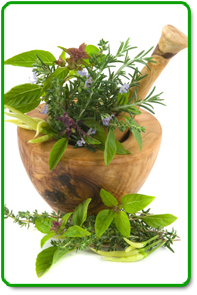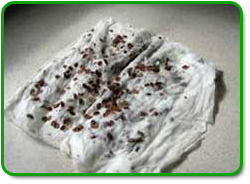The growing of herbs for use in tinctures, salves, infusions, poultices and other traditional preparations is an art form handed down through the ages. This is perhaps the simplest and truest way to reconnect to our medicinal heritage, and is the foundation of nearly every system of healing. While it may seem daunting at first due to the special needs of some medicinal herbs, with patience and persistence you will be able to generate your own remedies for use at home or in the field, and work towards a life of greater self-sufficiency.
|
|
| |
|
|
| |
|
|
| |
| Guide to Growing Angelica |
|
Guide to Growing Boneset |
|
Guide to Growing Calendula |
 |
Legend says, Angelica was revealed in a dream by an angel to cure the plague. |
|
 |
Used by North American Indians for stomach problems, colds, & fevers, in addition to arthritis. |
|
 |
Calendula is added to salves
& other topical preparations & has been shown to speed the healing of wounds. |
| |
| Guide to Growing Chamomile |
|
Guide to Growing Echinacea |
|
Guide to Growing Feverfew |
 |
The anti-inflammatory properties make it good for rheumatism, arthritis, and other painful swellings. |
|
 |
Echinacea has been used in North America for more than 400 years to treat infections, wounds, & a general cure-all. |
|
 |
Feverfew was first introduced to North America by European settlers in the 17th century. |
| |
| Guide to Growing Mullein |
|
Guide to Growing Nettle |
|
Guide to Growing Pleurisy Root |
 |
Greek mythology holds that Ulysses carried Mullein to protect himself from the evil Circe. |
|
 |
Nettle has been used for 100s of years to treat painful muscles and joints, eczema, arthritis, gout, and anemia. |
|
 |
Some Native American
tails tell of the roots
being used
as a body wash
for lifting & running strength. |
| |
| Guide to Growing Skullcap |
|
Guide to Growing Spikenard |
|
Guide to Growing Tobacco |
 |
Skullcap was well known among Native American healers as a strong female medicinal herb. |
|
 |
Spikenard shares many common properties with its close relative American Ginseng. |
|
 |
Many homeowners wish to grow tobacco in their yard
or garden for ornamental purposes or personal use. |
|
| |
|
|
|
| |
|
Some tips on medicinal herbs:

Starting Herb Seeds
Herb seeds, and many medicinal herb seeds in particular, require considerably more care and patience than other types of seeds. We recommend starting all medicinal herbs indoors in flats or small containers some weeks prior to the final frost of spring to make best use of sometimes rare and often expensive seeds. When sowing, use between 1-3 seeds per hole unless seeds are prone to low germination rates. Too many starts growing together can be difficult to separate later and both may show impaired development. If you do have 2 or more starts growing in close together, thin down to one and replant (or comsume) extra sprouts. After sowing cover flat (or container) with clear plastic lid or plastic wrap to retain moisture until seeds have started to germinate and poke through the soil-medium.
Soil for Herb Seeds
Do not use garden soil or other soil from your yard to start medicinal herbs. Such mediums may not be sterile & can be often contain mold or fungus which can be detrimental to germination seeds & young starts. Common soil may also contain excessive amounts of clay, which will not allow for proper drainage.
Always use a sterilized, organic potting medium that is rich in nutrient content yet offers good drainage. Your medium should be of a fine, rather than a coarse consistency, to ensure good seed-soil contact that will deliver the necessary moisture for germination. Keep your soil moist, especially prior to germination, and be gentle when watering so as not to disturb your seeds, especially tiny seeds which may be sown at a very shallow depth or on top of the soil. A spray bottle, saturated paper towel, or very gentle water can may be the best bet in such cases.
Herb Seed Treatment
Many medicinal herb seeds require special treatment such as stratification or scarification for germination. Such requirement may seem daunting, but do not be discouraged! Such treatments are necessary to simulate the natural conditions needed for development, and effectively prevent such seeds from germinating until conditions are ideal.
 Stratification is used to simulate the cold, moist springtime conditions certain temperate seeds encounter in nature. This can be done in your refrigerator with a resealable baggie and either a paper towel or a small quantity of pearlite. The time needed for stratification varies slightly among those that require this process, but all will require more time and planning than other seeds. In some cases, beginning your stratification in late or even mid winter may be necessary to produce sizable starts at the appropriate time for transplanting. Stratification is used to simulate the cold, moist springtime conditions certain temperate seeds encounter in nature. This can be done in your refrigerator with a resealable baggie and either a paper towel or a small quantity of pearlite. The time needed for stratification varies slightly among those that require this process, but all will require more time and planning than other seeds. In some cases, beginning your stratification in late or even mid winter may be necessary to produce sizable starts at the appropriate time for transplanting.
 Scarification is required less frequently among herb seeds than stratification, and is accomplished my inflicting minor abrasion to the seed coat with a spoon or other object. This is to simulate the digestive process of birds and mammals that consume such seeds and pass them under natural conditions. Scarification is required less frequently among herb seeds than stratification, and is accomplished my inflicting minor abrasion to the seed coat with a spoon or other object. This is to simulate the digestive process of birds and mammals that consume such seeds and pass them under natural conditions.
Transplanting your Herbs
Transplant outdoors once the average date of the final frost of the spring has passed. Most starts will be ready for transplanting with the appearance of their first (or second) set of true leaves, not to be confused with cotyledons, the first leaf-like structures to appear. If starting in flats or shallow containers, do not wait too long to transplant as the roots can become stifled in the bottom of your container and inhibit development and growth later on.
For best results, gradually 'harden' plants for outdoor transplanting by exposing in increasing amounts of sunlight and outdoor conditions, but do not leave containers outdoors overnight if concerned about spring freeze. Try to transplant on a cloudy overcast day to minimize the possibility of immediate shock from sunlight and heat.

|